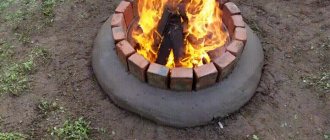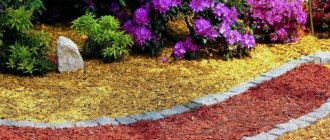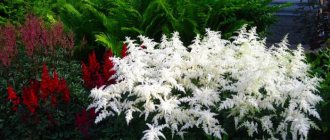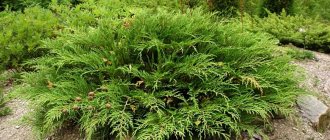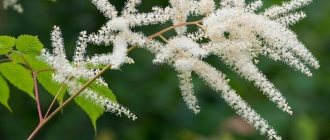The use of fills in the landscape - organic mulch, chipped or rounded small stones, sand, etc. - literally transforms the garden plot. They can be used very widely - from paving paths and patios to decorating flower beds. Where accuracy is especially in demand, you can’t do without them.
Mulching (namely, the use of fillings of any kind is called) has a long history, its own traditions and laws. Every gardener knows about the beneficial properties of mulch: it helps to almost completely destroy weeds; protects the soil from night frosts in the spring-autumn period and from deep freezing in winter (for example, in places covered with nut shells it will be 10-15 cm, and in places not covered - 20-25 cm or more); prevents overheating, drying out and caking of the surface layers of the earth. In addition, some fills can serve as a source of necessary substances for the soil (for example, pine needles can, where necessary, increase its acidity), create a barrier to pests and stimulate the proliferation of beneficial microorganisms.
The principles of using fills change significantly over time. Their transformation is spurred by both the emergence of innovative materials and the birth of new styles. And if, say, in formal gardens (French, Italian, Moorish styles) they carefully tried to get rid of weeds by mulching large areas, then in naturgarden gardens, on the contrary, they welcome the invasion of wild plants and use fillers in a completely different context and in limited quantities - for example , to bring color to the garden palette.
All mulching materials are divided into organic and inorganic.
Colored decorative fills are an invariable attribute of the design of alpine slides, rockeries, and “dry streams” in Japanese gardens. With the help of bulk stone “mosaics”, ornaments and panels, you can exclusively decorate the area of fountains, water cascades, and the banks of miniature artificial ponds
The easiest way to create a beautiful lawn in front of your house
Many of us have admired beautiful, well-kept gardens. Creating them is a great work, and the use of special design solutions helps to make it easier. One of them is decorative filling. To create it, you need materials that have a granular structure. Each of them contains identical elements of different sizes and different shapes. Therefore, when pouring them out, it is possible to create beautifully decorated corners. Today, paths, the banks of artificial reservoirs, and corners of artificial landscapes in the style of a Japanese garden are designed in this way.
Landscape sand in a Japanese garden Source avatars.mds.yandex.net
Filling with bark, stone chips, pebbles, sand, crushed shavings, glass and plastic balls is useful not only for its aesthetic properties. It is a practical design element. Thanks to its use, it is possible to reduce the number of weeding of flower beds, prevent excessive evaporation of moisture from the soil surface, and reduce the amplitude of fluctuations in soil temperature. Thanks to this, plants receive less stress, which means they grow better, which should please any gardener.
Backfill in garden landscape design has aesthetic and practical functions Source zemeljka.ru
There are two types of decorative fill: one is of organic origin, the other is inorganic. Each has its own pros and cons. Knowledge about them helps to make the right choice of material.
Organic
This type of filling is widely used in landscape design. It is made from pine bark, or cedar processing waste. It is unrealistic to make it yourself: for this you need to set up an entire production. But this is not necessary; you can buy organic filling in any specialized store. This choice has advantages:
- The material is inexpensive, in fact, it is waste from the woodworking industry; large and small workshops operate everywhere, which simplifies the task of delivery.
- Pine bark and cedar sawdust are natural materials; they can rot on their own, and this is an additional fertilizer for the soil. Even if sawdust is sold in painted form, you should not be afraid to fill the playground with it: natural paints are used for coloring. They are non-toxic and therefore completely safe for human health.
Filling made with wood chips Source i.pinimg.com
The properties of the material also determine the disadvantages of its use. The lower layers of the fill, if they are not separated from the soil by a film, quickly rot and deteriorate the quality of acidic soils. The fragility of the material forces the filling to be done again and again, in this way it will be possible to maintain its constant quantity and quality. But these are additional expenses.
If sawdust is well dried, the wind easily carries it throughout the garden area. And this has a bad effect on the appearance of the entire design as a whole. To prevent such incidents, experts advise erecting a border of stones around the fill. And this will also help increase the cost of organizing a beautiful lawn or path.
Any organic fill must have a border Source avatars.mds.yandex.net
On our website you can find contacts of construction companies that specialize in landscape design, landscaping and creating decorative forms. You can communicate directly with representatives by visiting the “Low-Rise Country” exhibition of houses.
Inorganic
It can be of natural or artificial origin. In the first case, a person extracts materials from the environment, and they then do not undergo additional chemical processing. These include:
- Crushed stone is a loose structure that may contain different types of stone (slate, marble, quartzite). Because of this, stone filling in landscape design can be of different colors. This is convenient when there is a need to create complex patterns. Crushed crumbs have sharp corners and edges, so when poured, they lay down in a layer that has a good volume.
- Sand is a material with the finest fraction of one rock. When decorating the garden, well-washed river or natural sea sand is used, as well as sand obtained from the extraction of marble, expanded clay, and shell rock.
- Gravel is a material containing small and medium-sized solid pebbles, usually used to create garden paths.
- Pebbles contain small and large pebbles that have a round shape and a smooth surface. They are best suited for creating dry streams.
Dry streams created using different types of inorganic fill Source vipsad.com
The main advantage of choosing such materials for creating fill is their durability. Stone chips retain their decorative properties for a long period of time; they do not rot, do not fade in the sun, and do not lose their color. Such backfill does not require maintenance; weeds very rarely grow through it, and if this happens, they are pulled out of the ground much more easily.
Pebbles and crushed stone look good together Source cdn2.hubspot.net
The main disadvantage of this choice is the difficulty of autumn cleaning. Removing fallen leaves is difficult: you can’t take revenge, you can’t work with a rake. The only way out is to blow it off with a special vacuum cleaner. But not everyone in the family has such a garden tool. Over time, the stone fills silt and become covered with green moss. It's difficult to fight him.
It will be difficult to keep such beauty clean Source huskiezlandscaping.com
Inorganic fill of artificial origin is created using polymer balls. They can be of different colors and are obtained by recycling plastic products. Chemical components are used in the production process. But they are completely safe for human health. You can fill up such material by first laying a film or geotextile on the base. Otherwise, the backfill will constantly sag: the balls will mix with the ground, get dirty, and the appearance of the backfill will suffer as a result.
Filling with artificial decorative crushed stone Source static.wixstatic.com
Which gravel is best to choose?
Each of the materials listed above has advantages and disadvantages. Decorative gravel is generally expensive, especially for slate. A good option is crushed stone with a fraction of no more than 2 cm. It is best to stick with gray, but if it seems too boring, you can dilute it with a pink tint. Construction pebbles are the cheapest option. You need to choose the same faction.
Gravel paths should not be very colorful. Many also do not advise choosing stones of different colors, since they will not fit into the garden.
Selecting the color shade and shape of gravel
The green plants are well accentuated by the gray crushed gravel. In general, it is inappropriate to use colored gravel in the garden - there will be an imbalance. It is important to choose the right shape of stones, because the accuracy of the landscape depends on it. There are several tips to follow:
- Use materials that are already in the garden. This way they will fit better into the interior of the garden.
- Choose material of the same type so as not to cause imbalance. However, sometimes crushed stone is combined with pebbles, creating a smooth flow from one form to another. It looks beautiful.
- Do not use large, unnaturally shaped stones. They can only be used for decoration.
- River gravel paths look great. Since it is quite dark, it can be diluted with gray stones.
Application examples
Until recently, gravel filling in landscape design was used only to create a patio; today, the scope of application of loose structures has expanded significantly. With their help, tracks are often created. All types of listed materials are suitable for these purposes, except for inorganic artificial materials.
Stone screes in rock gardens Source nashgazon.com
Backfill helps create the effect of “stone screes” in rock gardens, form mounds of alpine hills, and emphasize the beauty of individual plants. Plant a spreading flowering bush in the center of a stone clearing, and you will see how well such a soloist will demonstrate its beauty. Designers love to use bulk materials when creating flower beds or to form separate zones. They help prevent the growth of plants: areas of bare soil between them will eventually be filled with grass, and this will have a bad effect on the decorative properties of the individual element. When the open ground is filled with crushed stone or gravel, pine bark or cedar waste, the garden will take on a finished appearance.
Backfilling helps give the garden a finished appearance Source avatars.mds.yandex.net
High-quality decorative filling of slopes with crushed stone at the dacha also helps to solve complex practical problems. It prevents the spreading of the earth, covers a large area, and hides its most unsightly sides. Make the fill multi-colored, get a bright decorative element that will immediately catch the eye and distract attention from other imperfections of the site.
What kind of material is this, production
Colored decorative crushed stone is an artificially colored fractional stone. Several types of crushed stone are used for painting: granite and marble, less often limestone. These breeds lend themselves best to dyeing. The technology for producing colored crushed stone includes several stages. The raw material is crushed stone of natural origin, the extraction of which includes determining the location of the future quarry, developing the deposit, cleaning the area, stripping, breaking the rock (several methods are used), crushing, screening (sifting) and sorting.
Fractions of marble crushed stone. Photo Petrovich
For painting, crushed stone sorted into fractions can be used, then it is possible to begin painting immediately. If unsorted fractions act as raw materials, then the first technological stage will be sifting on a vibrating screen, hence the alternative name of the process - screening.
Modern enterprises use high-quality products for painting that are resistant to weather influences: precipitation, direct sunlight, temperature changes. Manufacturers use acrylic or, most often, polymer paints, available in a wide range of colors, which are non-toxic, do not harm plants and do not come into contact with the soil.
Reference! Unscrupulous manufacturers use inexpensive paint products, which affects the service life of colored crushed stone, which begins to fade in the second year. Also, enterprises, to the detriment of quality, save on raw materials, quantity of paint, and drying process.
For painting, a special hopper is used, the operating principle of which is similar to the operation of a concrete mixer. The ratio of components loaded into the hopper is five parts crushed stone and one part paint. After painting, the crushed stone is placed in a drying chamber. The final stage is packaging. Bulk materials are sold in bags weighing 2-20 kilograms.
Features of installation and care
Laying decorative soil should begin with drawing up a plan for its placement. It will help you understand what the expected consumption will be and where the coating areas will be located. Then the site is marked according to the planned plan. To do this, pegs are driven into the ground and threads are stretched between them.
The area inside the marking is cleared of debris and weeds. The turf is removed from above and a trench is formed to the depth of the backfill (usually its thickness is 7 cm). Geotextile or polyethylene film is laid on the bottom. If it is used, holes must be made on its surface. They will allow excess moisture to go into the ground. This will help prevent the formation of silt on the surface of the stone fractions.
Marking for filling paths Source lipeck.ridatex.ru
If you plan to plant plants inside, this is done at this stage: a hole of the required diameter is made in the film, a hole is dug under it, and seedlings are planted into it. At the final stage, the base material is poured. With this installation, gravel backfill in landscape design will last a very long time. She will perform all her functions. But you still have to look after her periodically. To do this you need:
- weed plants;
- clean the surface of debris;
- add base material if necessary.
How to fill a site for building a house. When to backfill
There are many cases where the quality of a site can be significantly improved using this labor-intensive and expensive, but effective procedure. True, there is one “but”: before filling, even in cases where it seems to be “shown”, it is necessary to carry out work to study the geology. Topographical survey will show what the scope of leveling work will be, and “geology” will determine how high the groundwater is and what the composition of the soil is. In general, the backfill plan is determined based on a preliminary study of the site. But here is a general list of cases when backfilling is most likely very appropriate for you.
- The plot is flat, good, but completely “sits” in a lowland - both the neighbors and the road are higher. It is better to “raise” such an area - otherwise all the surface stormwater has a chance to collect on your area. However, if you plan to grow rice or a frog farm, leave everything as is.
- Large construction waste is scattered around your property. For example, if you bought an old house on 6 acres, dismantled it, but it doesn’t want to leave you so easily and is now found throughout the entire site - either in the form of a pile of stones from the foundation, or in the form of a board with nails. In some cases it is cheaper and easier to remove all this garbage and recycle it, but sometimes there is too much of it. And then it will be more convenient to distribute it evenly and fall asleep out of harm’s way.
- There is a real swamp on the site. Again, fans of living ecosystems may like it. If you have enough money and enthusiasm, you can turn a swamp into a charming pond. But if you just want to build a house, be able to sit on the veranda without being accompanied by frogs and mosquitoes, or grow carrots, the wetland must be filled in.
Briefly about the main thing
Decorative filling on the site is carried out using various bulk materials. This can be pine bark, cedar chips, gravel, sand, crushed stone, river and sea pebbles. The advantage of organic compounds is that they are affordable, inorganic bedding lasts a long time and does not require maintenance. With their help, you can solve aesthetic and practical problems: decorate patios and garden paths, the space around large soloist plants, create the slopes of alpine slides, strengthen the slopes of the earth, cover “bare areas”.
Ratings 0
We use crushed stone instead of pebbles
It is not always possible to get pebbles for decorating a garden - in such cases, much more affordable crushed stone, sold literally on every corner, can come to the rescue. It may not have such a smooth surface, but with the use of a number of simple manipulations it can be leveled out quite well. We proceed from the fact that we have already prepared a container of suitable size for mixing - a basin, a trough, a concrete mixer. All work is carried out in stages:
- We fill in the selected and sorted crushed stone in the amount of 3 parts
- Fill the container with paint and mix the contents
- Pour in clean water, 2 times larger in volume compared to the volume of paint
- Mix everything again, add 1 part of the cement mixture and mix again
- Add the next 3 parts of crushed stone and mix one last time
- We take out the pebbles covered with a layer of the resulting colored cement mortar and lay them out to dry on polyethylene, mesh or other clean, smooth surface
Recommended reading
Made from concrete
This type of material for garden paths is considered the most practical of all its varieties. The main advantages of concrete curbs are durability, ease of maintenance, and resistance to weather conditions.
There are two ways to make such a structure with your own hands. The first method is to cast curb blocks using special molds. It is not recommended to buy a special form because of its standard dimensions, which are not always suitable for arranging paths made at home.
Tools and materials
To make your own mold, you must use the following materials:
- drill-driver or screwdriver;
- screws with non-countersunk heads;
- long, smooth, planed bars;
- a clean and smooth sheet of metal or thick plywood at least 5 mm.
To make a concrete curb, you must have the following materials available:
- water;
- crushed stone;
- cement grade 400 or 500;
- sand;
- decorative elements;
- reinforcement or wire with a thickness of 4–6 mm.
Sequence of work
To make such a structure, you must follow these steps sequentially:
- Attach the bars that will correspond to the size of the future block to the surface of the sheet or plywood using screws.
- If the sheet is large, then you can make several formworks with adjacent sides.
- It is advisable to make a mold for the border with a length that varies between 1000–1200 mm. Otherwise, there is a high risk of the block breaking.
- The width and height should have an approximate ratio of 1/2–1/4.
When making a concrete curb, you should perform the following sequence of operations:
- Immerse the crushed stone in water or pour it over so that it is saturated with moisture and adheres well to the solution.
- Mix dry cement and sand in a ratio of 1:4 or 1:3 until a homogeneous mass is formed. It is advisable to use a construction mixer.
- Add crushed stone and water to the dry mixture.
- Mix everything again. When mixing there should be no lumps of dry sand with cement.
- Use a level to set the shape.
- Lubricate the bottom and formwork with oil or grinding so that it is easy to remove the workpiece from the mold.
- Fill the prepared form with concrete halfway.
- Then lay the reinforcement. To do this, first tie the connection points with wire.
- Fill the remaining space in the mold with concrete mixture.
- Level the surface of the future block with a trowel.
- While the concrete is drying, moisten it with water for 2–3 days, especially if the weather is hot.
- After drying, the form can be disassembled.
- Once completed, the formwork is cleaned and reassembled.
Manufacturing a monolithic border
Monolithic is another option for a concrete curb. This design is used for making flower beds and flower beds. It cannot be changed in the future, but during casting you can make a bend, an oval or a smooth rounding. Making such a border is much simpler because there is no need to prepare a mold.
Manufacturing stages:
- In the construction site, dig a trench, the depth of which will be one third of the total height of the curb. The bottom of the dug trench should be level.
- Prepare the formwork. To make formwork, it is enough to use wave slate, sheets of metal, plywood, and corrugated board.
- From the outside of the wall, drive steel pins into the ground that will hold the formwork.
- Prepare a concrete mixture and pour it into the formwork.
- To prevent the appearance of voids in concrete, you can use a construction vibrator or conventional reinforcement, introducing it into the poured mass.
Having made the border, you need to cover it from direct sunlight during the drying process. You should also wet the border with water every day to prevent it from cracking.
How to paint material for mulching or decorating an area with your own hands?
Painting crushed stone yourself at home allows you to save a lot of money. The cost of small colored crushed stone ranges from 19 to 30 rubles/kg. This means that you will have to pay a decent amount for decorating flower beds or filling paths. At the same time, the price of simple crushed stone of fraction 5–10 is about 1000 rubles. per cubic meter. This difference in costs is a strong argument in favor of making colored crushed stone yourself. This operation can be carried out manually or using mechanisms.
The choice of method depends on how much gravel you need to paint. If you do everything correctly, then, literally, in a couple of days you can get the right amount of beautiful and cheap material, and with a small volume of crushed stone, the whole job can be completed in a day.
Necessary equipment and tools
List of tools for painting:
- shovel;
- mesh with small cells for drying crushed stone after washing and painting;
- a spacious container, for example, a bathtub that has fallen into disrepair;
- protective gloves;
- bucket;
- paint sprayer (for painting a small volume of material).
Which paint to choose?
Decorative crushed stone can be painted in natural shades (black, gray, beige), neutral (blue, green, white), bright (yellow, red). Since crushed stone is intended for outdoor decoration, it must be coated with paint that is resistant to frost, heat, rain and friction. Such materials are acrylic and polyacrylic paints and enamels.
Dye options for crushed stone:
- acrylic-styrene paint AK-539 (paint based on acrylic copolymers, used for applying road markings, price from 50 to 100 rubles/kg, drying time - 30 minutes, colors - white and yellow);
- acrylic-water dispersion VD-AK-191 (used for painting concrete, waterproof, low-flammable, price about 650 rubles per 5 kg, tinted with pigment fillers, drying time - about 5 hours);
- paint “Akrodom-F” (based on acrylic-styrene resin, fits well on the surface of the stone, retains color in outdoor conditions for up to 6 years, 28 shades, drying time - about 2 hours, costs about 230 rubles per kg);
- AK-511 paint (designed for road markings, white, red, yellow, black, dries in half an hour, price - about 100 rubles per 1 kg, flammable);
- alkyd enamel PF-115 (pentaphthalic paint, the first number 1 in the number means that the paint is suitable for outdoor conditions, drying time 16–24 hours, depending on the color, price 1 kg from 60 rubles).
Crushed stone coloring technology
The first stage of work is preparing crushed stone for painting, namely:
- removal of foreign particles and large fragments (ideally using a “rumble” sifting apparatus);
- washing with water or soap solution;
- drying by blowing air or naturally.
The washed and dried stones are placed in a concrete mixer container and a primer mixture consisting of a small amount of paint and a suitable solvent is added. This operation is mandatory for crushed stone with a porous surface; it helps close the pores and achieve a more even color. Smooth pebbles can be painted without prior priming.
Paint is added at a ratio of 1:5, where the coloring solution makes up 20% of the mass of crushed stone. Then the concrete mixer is started for a few minutes to mix. Painted crushed stone is laid out to dry on a tarpaulin or mesh with small cells. After drying, colored crushed stone is ready for use. If you need to get several different colors, then the concrete mixer must be thoroughly rinsed after each portion.
Where is it used?
Decorative crushed stone and decorative gravel are universal materials used to solve many problems in the field of landscape design. In particular they are used for:
- creating unique colorful compositions;
- for the production of individual decorative elements and paving slabs;
- pouring mosaic areas;
- arrangement of embankment paths and platforms;
- mulching the soil;
- decorating the banks and filling the bowls of artificial reservoirs (through the use of waterproof paint);
- creation of small architectural forms;
- production of decorative plaster;
- arrangement of a blind area around a country house and outbuildings;
- framing monuments and obelisks;
- creating alpine slides;
- imitation streams (dry stream);
- installation of decorative concrete fences.
A dry stream made of natural painted stones is an excellent alternative to a waterway. Source novogran.com.ua
How to distribute material by size
Before painting crushed stone, it is necessary to divide the material into fractions and distribute them by size. This is necessary for ease of further use, as well as to ensure uniform painting.
This stage is carried out independently, manually, using special sieves with different sizes of holes, and it can also be carried out using special technologies. For example, such as a “screen” - this is a system that is needed to separate bulk substances into fractions according to particle size.
By sifting the material, you can obtain not only crushed stone of a suitable size, but also eliminate various debris and dirt that are always present in it.
It is better to load crushed stone into the “rumble” using a loader or an ordinary shovel. In addition, if you don’t have a “screen” at your disposal (and this is not a cheap machine), you can always use a sieve
It is only important to choose it with cells of the correct size
During sifting, the sieve must be set at an angle and worked carefully, avoiding overfilling of material. Crushed stone larger than 1 cm in size is best suited for painting, so it is this that needs to be separated. The resulting crushed stone must be washed under running water, stirring it occasionally
This can be done using a shovel or other device that is convenient to use now
The resulting crushed stone must be washed under running water, stirring it occasionally. This can be done with a shovel or other device that is convenient to use now.
It is especially important to allow the crushed stone to dry completely after washing. Wet stone will not hold paint well.
Using fills in the landscape
Decorative fills are most widely used in the design of paths and patios. However, they can be used as decorative mulch in flower beds, as a low-maintenance alternative to lawns, and for decorating tree trunks.
All types of decorative fills (including organic ones) can be used to create paths. To form such a path, a shallow pit is dug, geotextiles are laid (to prevent weeds from sprouting from the soil), and then backfill is poured. The optimal layer is about 7-10 centimeters. To prevent the path from “creeping”, you can strengthen its edges - for example, by laying them with a stone of a larger fraction.
Using the same technology, large free spaces can be decorated with backfill (as an alternative to a lawn or, for example, as an element of a Japanese dry garden). By combining fills of different colors and fractions, you can achieve interesting effects. To diversify the composition, you can add one or two expressive green plants to it. To do this, a cut is made in the geotextile crosswise, and a plant is planted in the resulting hole.
In addition, fills can also be used as elements of various decorative compositions - for example, to create “stone screes” on alpine hills, in rockeries, on the shore of a reservoir. Sometimes backfills can serve to emphasize and highlight certain plants. In this case, it is a good idea to choose a fill that contrasts in color with the foliage of the plant.
Decorative mulching with organic materials can also be an excellent option when starting a garden and planting perennial plants. As you know, the first and second years after planting are traditionally losing years for most perennials.
If you plant them at a distance optimal for their further growth and development, there will inevitably be bare soil between the flowers, which most gardeners do not like.
However, if you decorate these spaces, for example, with wood chips, then the “voids” will look like part of the design idea, and the garden as a whole will take on a complete look. In contact with
Additional decor
You can decorate a flowerbed with all kinds of available materials. Uprooted stumps or tree branches of unusual shapes go well with flowers and greenery. To complement flowers and grass, you can plant ferns around the perimeter of the entire composition. Stumps and logs are often used as pots for planting plants.
- For decoration, you can use large boulders of original shape.
- Granite and sandstone blocks go well with bright grass and coniferous shrubs.
- The flower bed can be complemented with various figures of animals, birds or gnomes.
- You can even make such figures yourself from building plaster.
Also, natural or artificial moss is often used for additional decoration.
You can paint crushed stone yourself
You can choose the color you are interested in. Acrylic and alkyd paints and colored aerosol enamel in a can are used.
- First, the pebbles need to be washed well.
- Paint on one side and wait until completely dry.
- Paint the other side and also wait until the paint dries.
- There is no need to apply a thick layer of paint, but if the crushed stone turns out to be dull, the process will have to be repeated.
This method is suitable for painting a small amount of stones. If you need to paint a lot of pebbles, then you need to pour them into a large container, pour the paint on top and mix thoroughly (you can use a concrete mixer for this purpose).
How to get rid of weeds in a rose bed?
The rose garden is difficult to weed by hand because roses have thorns. This means that mulching for a flower bed with roses is necessary. And also when manual weeding, new growth and young shoots are inevitably injured. And wounds caused by garden pruners at the base of the bush can cause root cancer.
To control weeds in a rose bed, you can use selective herbicides, for example, Cletodim. But at the same time, you need to remember that even if the drug does not get directly onto the roses, after treatment they feel depressed and grow poorly. Therefore, use Kletodim only in extreme cases, when there are a lot of weeds and there is no way to pull them out.
You can walk along the edge of a flower bed with roses with the herbicide Glyphosate. It destroys harmful weeds such as creeping wheatgrass. Glyphosate is applied using a special roller device. When there is fog and high air humidity, it is better not to use Glyphosate.
Despite the good effect of herbicides in getting rid of weeds, it is better to use them only in emergency cases. The use of poisons affects the well-being of roses. This is expressed in the pale color of the leaves, relatively small buds and elongated sprouts.
The best way to control weeds in a rose garden is to mulch open spaces in the flower bed with natural or artificial materials. In this case, not only the plants themselves benefit, but also the overall appearance of the flowerbed.
Decorating with streamlined pebbles
Of course, crushed stone in a flowerbed looks unusual, but why not try streamlined pebbles? Then we need a large container, cement and paint. We do everything step by step:
- Pour a third of the crushed stone into the container, add paint, and mix thoroughly.
- Then pour water into the crushed stone, twice as much in volume as paint.
- Add cement (determine the quantity yourself) and mix everything. Then pour in the remaining pebbles and mix everything again.
- Place the stones, completely painted with cement, on mesh or polyethylene until completely dry. When the process is completed, you can see that the stones have become more streamlined and well painted. They can be used in the same way as decorative crushed stone.

